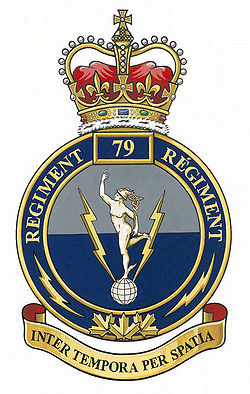79 Communication Regiment
79 Communication Regiment was authorized in 1990[1] and stood up in August. A strategic communications unit, it absorbed 1 Line Troop and, in 1993, the Long Range Communication Terminal (LRCT) detachments of 1st Canadian Division Headquarters and Signal Regiment (1 CDHSR).
The organization of the Regiment was undertaken by Canadian Forces Communication Command (CFCC) due to various issues that occurred during Op FRICTION. As was the standing practice at the time, 90 Canadian Headquarters and Signal Squadron had been created to administer and provide C2 for the Canadian contribution to Op FRICTION. However, there were numerous issues that came from not having a dedicated team for this task which only became apparent when conflict and message traffic at a higher level than the average UN mission occurred, including delay times so exaggerated that cargo loads of message traffic were taken by airplane to Lahr Germany for processing on the ADDN to speed the backlog.
79 Communication Regiment took over the National Rear Link (NRL) tasking, personnel, and equipment from 1 CDHSR (in the form of LRCT Tp), which was completed in 1993. They subsequently replaced the antiquated HF terminals with the MM Satellite Terminal, a deployable COTS satellite communication system funded under the Minor Projects budget.
Under CFCC, the ideal situation was to utilize the MM as well as reserve force soldiers to conduct NRL missions, as CFCC commanded all communication reserve units. These soldiers would all train together extensively as a unit and with the equipment, which would result in a more cohesive team and better C2 than was experienced in Op FRICTION.
Unlike army units, 79 Communication Regiment was well known for not conducting exercises, but maintained a task-specific posture throughout its existence where confirmation of training did not require the pretense of an exercise.
79 Communication Regiment was altogether successful in their attempt to revolutionize the NRL capability of the Canadian Armed Forces. They utilized COTS SATCOM technology while waiting for TCCCS OPCAP6 to become operational, and surpassed the design specifications of that system.
Originally the unit was headquartered in Ottawa with a detachment in Kingston, and plans were underway as early as 1994 to consolidate the entire unit in Ottawa. However, plans changed and in 1997 the unit was consolidated in Kingston, taking up residence under one roof at 741 Dalton Ave.
With the stand down of 1st Canadian Division in 2000 and its conversion into Canadian Forces Joint Headquarters, the signallers of 1st Canadian Division Headquarters and Signal Regiment were left without a headquarters to support and the decision was made to join the two units in Kingston. The Canadian Forces Joint Signal Regiment was formed in 2000[2] and the majority of 1 CDHSR members who were present for the stand down of 1st Division were transferred, along with the personnel from 79 Communication Regiment, to the new unit.
Commanding Officers
- LCol R.L. Lacharite – Aug 1990 to July 1991
- LCol D.A. Robb - July 1991 to August 1993
- LCol H.W. Coyle - August 1993 to July 1996
- LCol G.R. Thibault - July 1996 to June 1998
- LCol J. Gendron - June 1998 to June 2000
Regimental Sergeants Major
- CWO Gene Dubè, Aug 1990 - Sep 1994
- CWO I. Husk, MMM, CD, Sep 1994 - Jun 1999
- CWO J.H. Gelina, MMM, CD, Jun 1999 - Jun 2000
Lineage
| Unit lineage | ||
|---|---|---|
| Absorbed LRCT of 1 CDHSR |
79 Communication Regiment August 1990 - 1 June 2000 |
Absorbed by Canadian Forces Joint Signal Regiment |
| Absorbed 1 Line Troop | ||
Related Pages
- No related pages at this time


